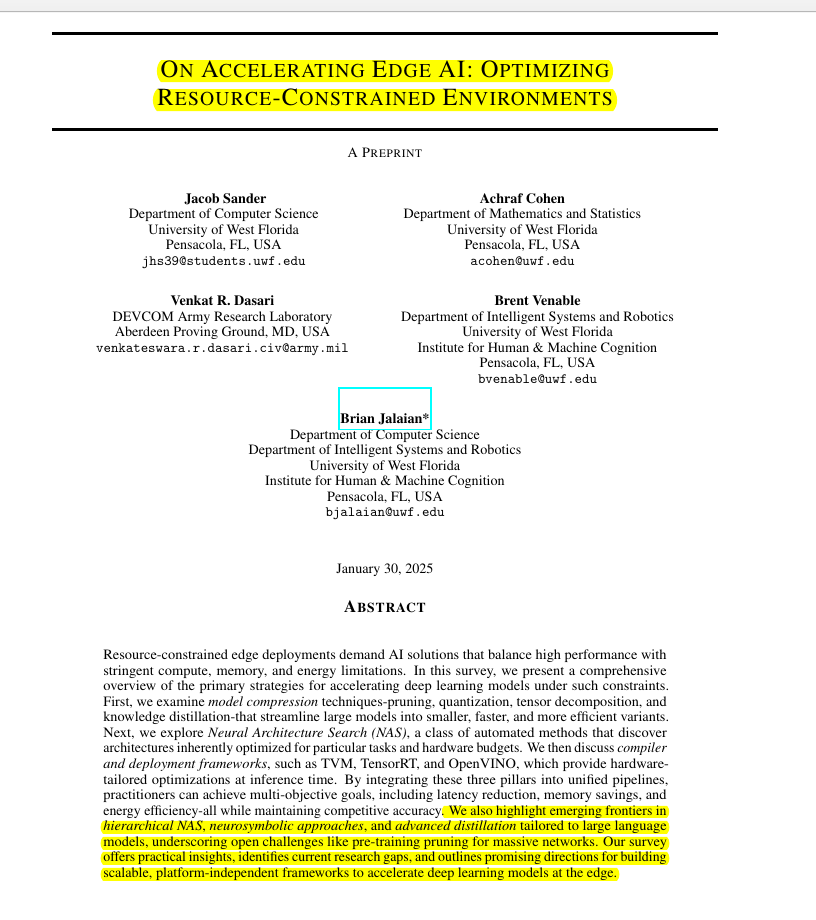"On Accelerating Edge AI: Optimizing Resource-Constrained Environments"
Below podcast on this paper is generated with Google's Illuminate.
https://arxiv.org/abs/2501.15014
Deploying complex models on resource-constrained edge devices is challenging due to limitations in computing power, memory, and energy. This paper addresses optimizing models for efficient deployment in such environments.
This paper proposes a comprehensive survey of model compression, Neural Architecture Search, and compiler optimization techniques to accelerate on edge devices. These methods aim to balance performance with resource limitations.
-----
Here are my technical perspectives on the paper's solution:
📌 The paper effectively synthesizes model compression, Neural Architecture Search, and compiler optimizations. This integration offers a practical framework for deploying efficient models on edge devices by reducing model size and inference latency.
📌 Neural Architecture Search combined with accuracy predictors and hardware lookup tables allows for automated design of efficient architectures. This method optimizes for multiple objectives like accuracy and latency simultaneously, crucial for resource-constrained environments.
📌 Knowledge distillation, especially techniques like flash distillation, provides a computationally cheaper way to train smaller, efficient student models. This method effectively transfers knowledge from large teacher models, maintaining performance while reducing computational cost.
----------
Methods Explored in this Paper 🔧:
→ This paper explores three primary strategies for optimizing models for resource-constrained edge deployments.
→ Model compression techniques are examined. Pruning, quantization, tensor decomposition, and knowledge distillation are key methods. These streamline large models into smaller, faster variants.
→ Neural Architecture Search is discussed. Neural Architecture Search automates the discovery of architectures optimized for specific tasks and hardware.
→ Compiler and deployment frameworks are analyzed. TVM, TensorRT, and OpenVINO provide hardware-tailored optimizations during inference.
-----
Key Insights 💡:
→ Integrating model compression, Neural Architecture Search, and compiler frameworks creates unified optimization pipelines.
→ This integration achieves multi-objective goals. Latency reduction, memory savings, and energy efficiency are improved while maintaining accuracy.
→ Emerging frontiers include hierarchical Neural Architecture Search and neurosymbolic approaches. Advanced distillation techniques for LLMs are also highlighted.
→ Open challenges like pre-training pruning for massive networks are identified. Scalable, platform-independent frameworks are crucial for accelerating deep learning models at the edge.
-----
Results 📊:
→ Mobilenet-v1-1-224 accuracy improved from 0.657 with Post-Training Quantization to 0.70 with Quantization-Aware Training.
→ Mobilenet-v2-1-224 latency reduced from 98 milliseconds with Post-Training Quantization to 54 milliseconds with Quantization-Aware Training.
→ Inception v3 model size reduced from 95.7 Megabytes (original) to 23.9 Megabytes (optimized).
→ TVM compiler achieved speedups of 1.2× to 3.8× across CPU, GPU, and FPGA platforms.


